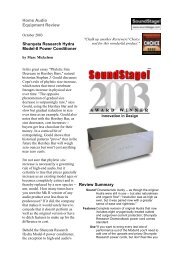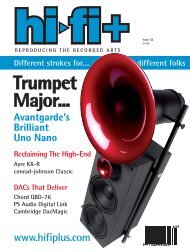Create successful ePaper yourself
Turn your PDF publications into a flip-book with our unique Google optimized e-Paper software.
MARSHALL NACK'S SYSTEM<br />
LOUDSPEAKERS<br />
Kharma Ceramique 3.2, Talon<br />
<strong>Audio</strong> ROC sub woofer.<br />
ELECTRONICS<br />
von Gaylord <strong>Audio</strong> (formerly<br />
Legend <strong>Audio</strong> Design) LAD-L2<br />
Signature line preamp, von<br />
Gaylord <strong>Audio</strong> Nirvana Mk II<br />
mono-blocks. Electronics in<br />
house recently or now: Lamm L2<br />
preamp, Lamm ML1.1 monoblocks,<br />
Master Sound 845 monoblocks.<br />
SOURCE<br />
<strong>solid</strong> <strong>tech</strong><br />
Rack of Silence<br />
as reviewed by Marshall Nack<br />
POSITIVE FEEDBACK ONLINE - ISSUE 13<br />
With this review, Marshall Nack joins Positive Feedback Online as an Associate<br />
Editor. Formerly a Senior Editor with The Stereotimes, Marshall brings with him<br />
many years of experience in fine audio, and five years of editorial work at ST. We<br />
welcome him to the editorial community of PFO!<br />
<strong>Note</strong>: this article was originally intended as a follow-up to the Rack of Silence review<br />
posted on Stereotimes by Greg Petan. (Interested readers who would like to read<br />
this prior review can find it at www.stereotimes.com/acc120503.shtm.)<br />
Assembly<br />
The Solid Tech Rack of Silence (ROS) arrived in two surprisingly compact and<br />
lightweight packages: a large cardboard tube for the four uprights and a medium,<br />
component-sized box for the struts and hardware. Everything was well packed, but I<br />
had imagined a full-sized four-shelf rack would arrive in something bigger and<br />
heavier. The surprise was that the ROS is shipped as a partially assembled kit.<br />
The kit wound up taking my wife and I the better part of an evening to assemble.<br />
Maybe we didn't read the instructions as thoroughly as we should have; make sure
Linn LP12, LINGO, EKOS<br />
tonearm, ARKIV II cartridge,<br />
American Hybrid Technology<br />
Non-Signature Phono Preamp<br />
modified by Walker <strong>Audio</strong>,<br />
Extremephono Limited Edition<br />
and Graham IC-30 Arm Cables.<br />
CEC TL1X transport, Zanden<br />
<strong>Audio</strong> Model 5000 Mk III DA<br />
converter, von Gaylord <strong>Audio</strong> 2<br />
chassis prototype DAC.<br />
CABLES<br />
Interconnects by Harmonic<br />
Technology, Stealth, von<br />
Gaylord <strong>Audio</strong> and Omega<br />
Mikro. Also in house now;<br />
Harmonix and Argent Pursang.<br />
Digital Cables by Stealth and<br />
Von Gaylord <strong>Audio</strong>. Also in<br />
house now; Harmonix, Argent<br />
Pursang. Speaker wire by<br />
Harmonic Technology, von<br />
Gaylord <strong>Audio</strong> and Harmonix.<br />
Also in house now; Argent<br />
Pursang. Power Cords by<br />
Harmonic Technology Magic,<br />
Omega Mikro, Golden Sound<br />
and Shunyata. Also in house<br />
now; Argent Pursang.<br />
ACCESSORIES<br />
PolyCrystal Racks and cable<br />
supports, Mapleshade<br />
Component Support System and<br />
Rack of Samson , Solid Tech<br />
Rack of Silence, Golden Sound<br />
Acoustic Discs, DH Squares and<br />
DH Cones, Walker <strong>Audio</strong> Tuning<br />
Discs and Valid Points for LP<br />
turntable, Harmonix RFA-78i<br />
Room Tuning Discs, RFS-66ZX<br />
Tuning Feet, RF-900 and RF-<br />
999MT Tuning Spike Bases,<br />
Acoustic System Resonators,<br />
Argent Room Lenses, Echo<br />
Buster and Sonex acoustic<br />
panels, Accuphase PS-500, Von<br />
Gaylord <strong>Audio</strong> "Live<br />
Performance" and Shunyata<br />
Hydra power conditioners, API<br />
model 110 conditioner for sub<br />
woofer, Furu<strong>tech</strong> e-TP80 and<br />
Ensemble Mega PowerPoint<br />
outlet strips.<br />
you do. After the first column you get the idea and it becomes easier, but the<br />
instructions were sketchy and that first column wasn't easy. An exploded diagram<br />
showing all the parts, their names and how they all fit together would have been<br />
helpful. Warning: ALL PARTS ARE COLOR CODED AND MUST BE ASSEMBLED<br />
ACCORDINGLY. Each piece is machined to fit its color-coded mate, and identical<br />
looking parts with different colored stickers are not interchangeable.<br />
The ROS Personality<br />
I first moved the von Gaylord <strong>Audio</strong> CD transport from the Polycrystal shelf where it<br />
had been sitting on Combak RFS-65 footers and placed it on the top, heavy-duty<br />
shelf of the ROS. Yeah, there were obvious differences.<br />
On Dance of the Night Creatures (Mapleshade MS 06032), featuring trombonist<br />
Thurman Green in small group jazz combos, the sound became complex and more<br />
interesting, also weightier with a darker tonal balance—quite the opposite of lean.<br />
When I heard Hamiet Bluiett come in and with his baritone sax solo a minute or two<br />
into the first track, uh-huh, there was no doubt—this was sound you could sink your<br />
teeth into. The sax itself was bigger and engaged you with enhanced body and<br />
presence. Macro dynamics had more authority, but at the same time little events<br />
were better defined. Ditto for the drum-kit occupying the deep right corner of the<br />
stage and the trombone dead center on track two. The enhanced body was<br />
accompanied by lots of little events becoming audible, and together these filled up<br />
the soundstage with a thick density of info. I like to think of it as becoming kind of<br />
chewy, with all kinds of interesting things going on.<br />
Next, I moved the power supply for the von Gaylord <strong>Audio</strong> pre-amp. Mezzo soprano<br />
Anne Sofie Von Otter exhibited much the same metamorphosis on Anne Sofie Von<br />
Otter sings Offenbach (DG 289 471 501-2), her body became fuller and warmer, and<br />
also more lifelike. The ROS adds a taut kind of flesh throughout the frequency<br />
spectrum, not the fatty or overhanging kind. Instruments gain body mass and,<br />
logically enough, their images also get bigger. They are stable and don't move about<br />
in space, but they are no longer pinpoint. This took a while to get used to, but now<br />
I'm certain these bigger, more massive images more closely approximate the<br />
genuine thing; after all, there ain't no pinpoint imaging in the real world, is there? On<br />
the rare occasions when I have heard actual imaging, it's always been a diffuse<br />
kind. After you get used to this, pinpoint imaging seems like a reduction and<br />
unrealistic.<br />
In both of these selections, one of the biggest changes was a tonal shift to the<br />
midrange. Apart from the well-known adage that the music lives in the midrange, this<br />
is a welcome thing because most of us have too much treble energy. I dealt with this<br />
problem by using a Shakti Online on the power cable to the pre-amp. After the ROS<br />
brought it in line, I was able to remove the Shakti and let some of the treble back. I<br />
do enjoy removing these various sonic band-aids; if you choose your components<br />
wisely they will sound better singing in their unadulterated voice, all else being<br />
equal.<br />
These effects brought to mind the Shunyata Hydra power conditioner. With its noise<br />
suppression and velvety deep black background, the Hydra presents instruments in<br />
greater relief and allows low-level information to come to the surface, while giving<br />
them more mass. Ditto for the ROS.<br />
I have to say there were exceptions. The Electrocompaniet EMC1 UP CD player,<br />
used as a transport, was artifact free and midrangy when placed on the ROS. Back<br />
on the Polycrystal shelf sitting on its built-in footers, it was not as smooth and not as<br />
neutral, but there was greater low-end slam and more treble. All in all, the<br />
Electrocompaniet EMC1 UP sounded more enjoyable on the Polycrystal rack. In this<br />
case, the component already had a lot of midrange energy; putting it on the ROS<br />
enhanced what was already sufficient, and it became too much.
Feet of Silence<br />
The Feet of Silence borrow design elements from both the ROS and the DOS. Like<br />
the ROS, the FOS use a stainless steel ball bearing as the point of contact with the<br />
component. On the ROS, the ball bearing is secured with a wad of Blutack on the<br />
crossbar. On the FOS, the ball bearing is fixed in an aluminum tube with its own<br />
damping. And, like the DOS, it has a suspension that needs to be tweaked. The<br />
FOS suspensions use rubber 'O' rings in place of metal springs. Depending on the<br />
weight of the component to be supported, you reduce or increase the tension on the<br />
FOS by adjusting the number of 'O' rings, or use a different gauge 'O' ring. The<br />
distribution of the component's weight might dictate more tension under the<br />
transformer area of the chassis, for example. You'll know you've achieved the<br />
correct suspension when the FOS displaces by 3 to 5 mm as you seat the<br />
component on it.<br />
Using the FOS on the ROS does another tonal shift back to the frequency<br />
extremes, while giving big gains in articulation and focus. The von Gaylord <strong>Audio</strong><br />
power supply literally opened up with more texture and sparkle when I put FOS<br />
under it. Similarly, the CEC TL1X CD transport sounded great on the ROS, but I<br />
detected that midrangy cast again and an associated congestion. Putting it on the<br />
FOS resulted in a transformation. Like the von Gaylord power supply, it opened up,<br />
with gobs more transparency, definition and dynamics, throwing images that floated<br />
in 3-D space.<br />
When I removed the FOS from under the Lamm L2 pre-amp control chassis, still<br />
leaving FOS under the power supply chassis, the sound was looser, more relaxed,<br />
more diffuse and, of course, had more midrange. There was more distance between<br />
you and the performance. Sometimes this is just what the system needs. I liked to<br />
listen to the Lamm L2 both ways. For me right now, I'm liking the enhanced<br />
midrange of the ROS without any FOS. <strong>Note</strong>: the Lamm's two chassis weigh in<br />
under 20 Lbs each and may not have been heavy enough to distend the FOS<br />
sufficiently.<br />
The Feet of Silence used by themselves apart from the ROS can have very positive<br />
results. Swapping the FOS for the Harmonix Combak RFS-65, my reference<br />
footers, was essentially a lateral move. They sounded different under the Von<br />
Gaylord pre-amp, but both were very good. I found the same results with the Von<br />
Gaylord <strong>Audio</strong> Nirvana Mk II mono blocks; both footers were very good. For me, this<br />
means the FoS are competitive with the best support devices available.
Setup Tweaks<br />
After assembling the ROS, there's still a good bit of tweaking to be done. If you opt<br />
for the Disks of Silence (DOS) footers, which replace the standard, rigid footers at<br />
the base of the four columns (a strongly recommended option), you need to mass<br />
load the rack. The key to getting the most out of the ROS with the DOS is to<br />
understand that it is based upon spring<br />
suspension. The DOS has a bunch of coiled<br />
metal springs that need to distend properly for it<br />
to function as designed. About 90 lbs minimum<br />
and 200 lbs max will do the trick. I found loading<br />
it with 100 lbs or more worked best. Without the<br />
proper weight and correct tension on the springs<br />
in the DOS, the resonant frequency of the ROS<br />
will be within the audio band—not good. By the<br />
way, there is no minimum required weight for<br />
each fixed shelf, but they do max out at 85 lbs,<br />
while the heavy-duty shelf has a 170 lb limit.<br />
The Rack of Silence with four fixed shelves and<br />
Disc of Silence footers under the columns, as<br />
used here, is fairly rigid. Putting some FOS under a component made it susceptible<br />
to environmental shocks, visible in it's jiggling, and raised my anxiety level about<br />
accidentally bumping into the rack and dislodging a component. Nothing ever<br />
happened, thanks G_D, but extra vigilance is required.<br />
Conclusion<br />
At the moment, I have three racks. Each has its own characteristics, and each<br />
sounds different. The Polycrystal tends to emphasize frequency extremes and thin<br />
the midrange, while enhancing definition. Overall, it gives a thinner, more focused<br />
sound with pinpoint imaging. The Mapleshade Rack of Samson, made from <strong>solid</strong><br />
maple slabs, lends the characteristically pleasing acoustic properties of the wood,<br />
while cleaning up mid-thru-upper bass resonances. The Solid Tech Rack Of Silence<br />
is a radically different design than those conventional racks. It employs a theory of<br />
resonance control based on light mass and various suspensions. You'll have to put<br />
aside your preconceived notions about mass loading and approach this project with<br />
an open mind. I found it to greatly enhance instrumental body, fullness, detail<br />
retrieval and dynamics, while sounding quieter, more artifact free. Realism and<br />
presence were improved and this heightened my involvement in the music.<br />
Depending on the component, you'll find each rack has usefulness. I like to keep all<br />
the phono gear on the Rack of Samson. And the Electrocompaniet EMC 1 CD<br />
player preferred being on the Polycrystal. But most gear was happiest on the Solid<br />
Tech Rack Of Silence.<br />
Apart form its unusual and esthetically interesting appearance, noted by fellow<br />
scribe Greg Petan in his review, the Rack of Silence is a serious tool for the<br />
audiophile on the edge. Used with or without the Feet Of Silence, it brought<br />
improvements beyond what my other racks offered, improvements that I wouldn't<br />
want to be without. Marshall Nack<br />
Overall Size: 21” W x 27” L x 35” H<br />
Weight: 35 pounds<br />
Solid Tech<br />
Klagerupsvagen 357<br />
S-212 36 Malmo<br />
Sweden<br />
TEL: + 46 40 491 352<br />
email address: info@<strong>solid</strong>-<strong>tech</strong>.net<br />
web address: www.<strong>solid</strong>-<strong>tech</strong>.net



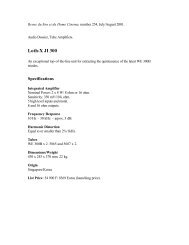
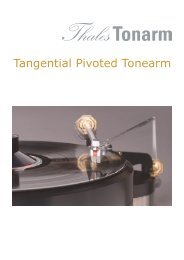
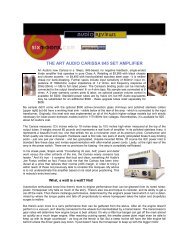
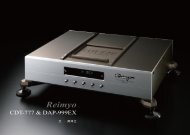

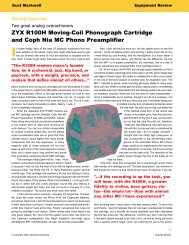
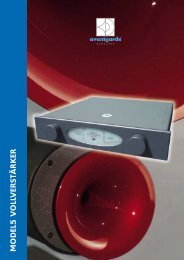
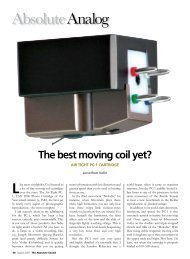
![DAP-999 EX Limited [pdf] - Audio Note Singapore](https://img.yumpu.com/27191044/1/190x253/dap-999-ex-limited-pdf-audio-note-singapore.jpg?quality=85)
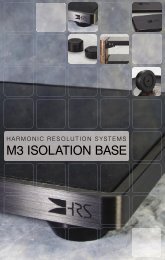
![Harmonix CS-120 Improved-Version [pdf]](https://img.yumpu.com/24411255/1/184x260/harmonix-cs-120-improved-version-pdf.jpg?quality=85)
